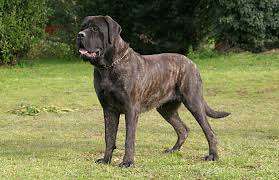Introduction
The English Mastiff, often called the Mastiff, ranks among the largest dog breeds worldwide. It is well-known for its huge size, easy-going nature, and loyal character. This breed has been appreciated for many years.
Learn more about: Gabapentin for dogs
Even though they look big and scary, English Mastiffs are often called “gentle giants” because they are friendly and protective. Whether you are thinking about getting one or just learning more about this amazing breed, this guide has all the information you need to know about the English Mastiff.

History and Origin of the English Mastiff
The English Mastiff has a long history that goes back thousands of years. Historical records indicate that dogs resembling the Mastiff were utilized by ancient civilizations such as the Babylonians, Persians, and Romans for fighting, guarding, and hunting.
The breed we recognize today started in England, where Mastiffs were used to protect homes, castles, and farms. They were also bred to take care of families and animals. Over time, their job changed from being fierce protectors to becoming beloved family pets.
Appearance and Size
One of the most noticeable traits of the English Mastiff is its big size. This breed is considered the heaviest dog in the world, with some males weighing more than 200 pounds.
- Height: 27.5 to 36 inches at the shoulders
- Weight: 120 to 230 pounds (females tend to be lighter, males much heavier)
- Body: Strong, muscular, and powerful
- Head: Large and square-shaped with a short muzzle and distinctive black facial markings.
- Coat: Short, thick, and straight
- Colors: Accepted shades include fawn, apricot, and brindle.
Even though they are big, English Mastiffs are not usually aggressive.
Temperament and Personality
The English Mastiff is often described as a calm, dignified, and loyal breed. They are excellent family pets and develop strong bonds with their owners.
- Affectionate: Mastiffs show deep love for their families, including kids.
- Protective: They naturally defend their home when they feel a threat.
- Gentle: Despite their size, they are usually kind and patient.
- Reserved with Strangers: While not aggressive, they might be cautious around people they do not know.
Mastiffs do best in quiet homes that can offer them company and a sense of safety.
Exercise and Training Needs
English Mastiffs are not very active, but they still need daily walks and some physical activity to stay healthy.
- Exercise: 30–45 minutes of gentle, low-intensity activity daily.
- Training: Training and socialization from a young age are important due to their size. They respond well to positive methods.
- Mental Stimulation: Toys that challenge their mind and obedience training help prevent boredom.
Because of their large size, Mastiffs take a long time to grow and may still act like puppies for many years. Training should start early and be consistent.
Grooming and Care
English Mastiffs are not too hard to take care of when it comes to grooming.
- Coat Care: Brush once a week to remove loose hair.
- Bathing: Bathe occasionally unless they get dirty.
- Drooling: Expect to see drool, especially after eating or drinking.
- Nails & Teeth: Trim nails regularly and brush teeth for good health.
Their short coat makes them easy to groom, but their large size means that grooming can take some time and patience.
Health and Lifespan
Like most giant breeds, the English Mastiff lives a shorter life than smaller dogs, usually between 6 and 10 years. Careful breeding and attentive care can help lower the risk of health issues.
Common Health Issues:
- Hip and elbow dysplasia
- Heart diseases
- Obesity
- Bloat (gastric torsion)
- Eye problems (entropion, progressive retinal atrophy)
Tips for Better Health:
- Provide a good, balanced diet
- Have regular vet checkups
- Avoid over-exercising puppies to protect their developing joints
- Keep them at a healthy weight
Nutrition for English Mastiffs
Feeding a Mastiff requires careful planning.
- Diet Type: High-quality dry kibble, fresh food, or a mix
- Protein: Important for muscle support
- Joint Support: Foods with glucosamine and chondroitin are helpful
- Meal Frequency: Split meals into 2 to 3 smaller portions to lower the risk of bloat
Consulting a veterinarian is recommended to develop a diet tailored to your Mastiff’s age, size, and activity level.
Living with an English Mastiff
Having an English Mastiff can be highly rewarding, though it also presents certain challenges.
- Space Needs: Mastiffs do well in homes with lots of room. Apartments can work if their exercise needs are met.
- Family Compatibility: They are great with children and usually get along with other pets if properly socialized.
- Commitment: Their size means higher costs for food, vet visits, and supplies.
Mastiffs are perfect for families who want a calm, loyal, and protective pet.
Pros and Cons of Owning an English Mastiff
Pros
- Loyal and protective family dog
- Kind with children
- Natural guard dog
- Calm and dignified nature
Cons
- Very large size can be hard to manage
- Shorter lifespan compared to smaller breeds
- Drools a lot
- Needs consistent training and early socialization
Is an English Mastiff Right for You?
An English Mastiff is not suitable for everyone. They need owners who are patient, confident, and able to manage a large dog. Given enough space, time, and dedication, the English Mastiff can be a highly rewarding companion.
Conclusion
The English Mastiff is a breed that shows strength, loyalty, and gentleness. Known as a devoted family protector and affectionate friend, this “gentle giant” is one of the most cherished large dog breeds in the world. With proper training, care, and love, the English Mastiff can become a lifelong friend that brings comfort and protection to your home.

